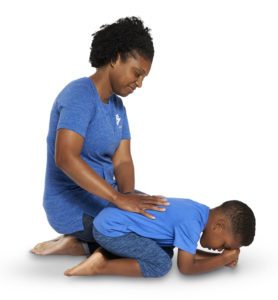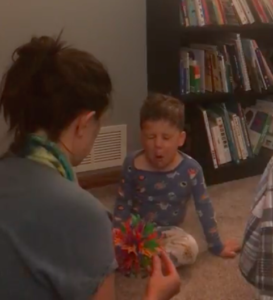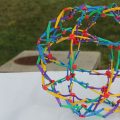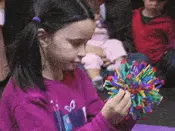Originally posted on the 1000 Petals Blog by Stephanie Kennelly
What should you do when an agitated child refuses to do any breathwork or movement?
We often say, “you are the intervention”. In fact, we dedicated an entire blog post to the idea of practicing these techniques for our own self-regulation before even beginning to teach youth. But, what does that really look like in practice?

This sounds simple, but in practice, can be quite challenging. Extreme behaviors in youth often trigger our own stress responses. This is expected and normal. However, it is at this point where we encourage the mindfulness practice to take over. Notice the child’s reaction with a non-judgmental lens, and choose another response from your toolkit.
The Hoberman Sphere is the way we begin to teach Belly Breathing, our introductory breath. This tool and breathing strategy is a great resource for self-regulation. The idea is that this practice becomes so engrained that its response becomes second nature.
Let’s paint a scenario. A student enters the office in an extremely agitated state. He has “flipped his lid” and is not accessing his “thinking brain”. You offer releasing breaths or other strategies that you have practiced before, but nothing seems to be resonating. Instead, he is only becoming more agitated. At this point, you pick up the Hoberman Sphere off of your desk. You begin to do deep belly breathing, even counting the breaths along the way.
By the time you get to ten breaths, you notice that the volume in the student’s voice has dropped and his body is starting to still. A this point, you could invite him to participate in the strategies again as you continue your deep breathing.

On a personal note, I’d also like to share how this strategy plays out at home with my own children.
My three year old was just finishing his first week of preschool. Emotional and physical exhaustion were at a maximum. Right before bed, an epic tantrum erupted. I recognized that he had “flipped his lid” and was operating in his lower brain. No amount of talking was going to turn the ship around. I brought out the breathing ball and asked, “Should we do some breathing?” The response was a resounding “NO” as he pushed the ball away.

We’re not expected to be perfect. These strategies can be difficult to remember in times of turmoil and don’t always turn around each situation. However, knowing that these tools and strategies are available can make difficult situations seem much more manageable. The most powerful part of this work is sharing with youth, that our brains and bodies always have another chance to try again with a different response.
Have you ever had a successful co-regulation experience? What has worked well for you? Leave a comment!




